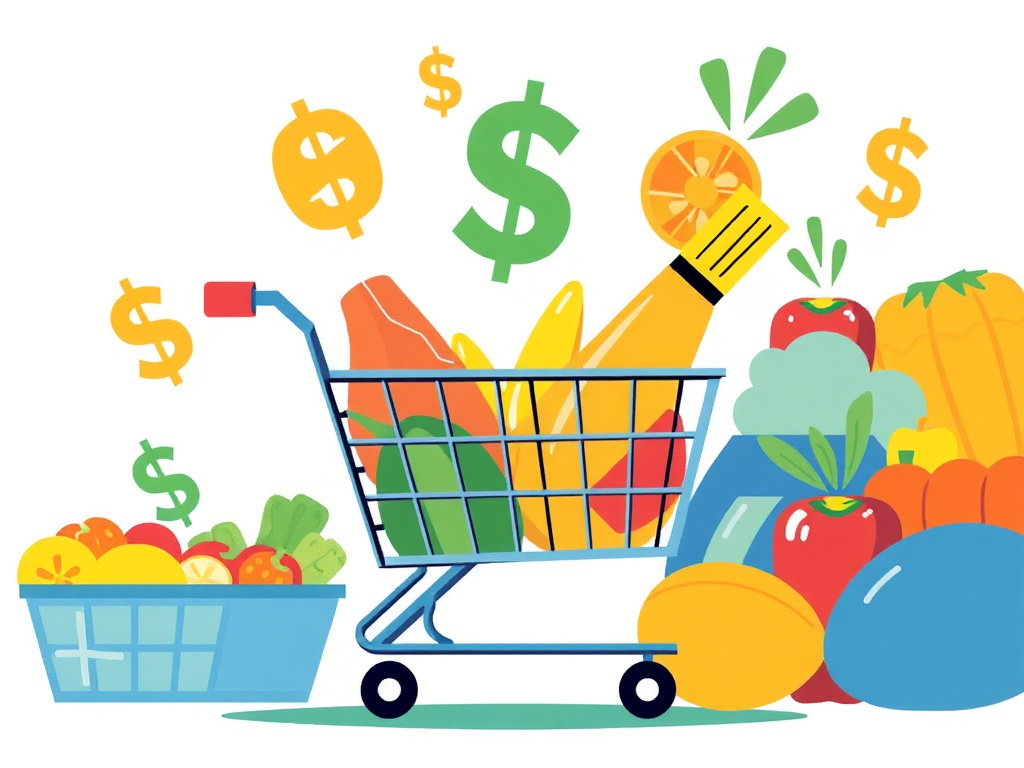The Average Family Spends $7,729 Per Year on Groceries
With inflation hitting food prices harder than ever, grocery bills have become one of the largest expenses for American families. The good news? You can dramatically reduce these costs without sacrificing nutrition or taste. These 25 expert-tested strategies have helped thousands of families cut their grocery spending by 30-50% or more.
Grocery shopping doesn’t have to drain your bank account. With strategic planning, smart shopping techniques, and a few insider secrets, you can slash your food budget while still eating well. Whether you’re feeding a family of six or shopping for one, these proven methods will transform how you approach grocery shopping and put significant money back in your pocket every month.
Before Optimization
Average monthly grocery bill for family of four
After Implementation
Optimized monthly grocery spending
Strategic Planning: The Foundation of Grocery Savings
Master the Art of Meal Planning
Meal planning is the single most effective way to reduce grocery spending. When you plan your meals for the week, you buy only what you need, reducing impulse purchases and food waste. Start by planning 5-7 dinners, then build your shopping list around these meals. This simple strategy can save you $200-300 per month for a typical family.
Inventory Your Pantry First
Before making any shopping list, conduct a thorough inventory of what you already have. Check your pantry, refrigerator, and freezer. Plan meals around ingredients you already own, and avoid buying duplicates of items you forgot you had. This prevents the common mistake of overbuying and reduces food waste significantly.
Create a Detailed Shopping List and Stick to It
A well-organized shopping list is your defense against impulse buying. Organize your list by store sections (produce, dairy, meat, etc.) to make shopping more efficient. Studies show that shoppers who use detailed lists spend 23% less than those who shop without one.
Smart Shopping Strategies
Shop the Perimeter First
Most grocery stores are designed with fresh, whole foods around the perimeter and processed foods in the center aisles. Shop the perimeter first for produce, dairy, meat, and bakery items. These whole foods are typically more nutritious and, when bought strategically, more economical than processed alternatives.
Master the Unit Price Comparison
Always check the unit price (price per ounce, pound, or item) rather than the package price. Larger packages aren’t always cheaper per unit. Many stores display unit prices on shelf tags, making comparison easy. This simple habit can save you 10-15% on your grocery bill.
Shop Seasonal and Local Produce
Seasonal produce is not only fresher and more flavorful but also significantly cheaper. Learn what’s in season in your area and plan meals around these ingredients. For example, buying strawberries in June versus December can save you 60-70% per pound.
Embrace Frozen and Canned Alternatives
Frozen vegetables and fruits are often more affordable than fresh and have comparable nutritional value. Canned tomatoes, beans, and other staples are pantry-friendly and cost-effective. Stock up during sales to maximize savings.
Coupon and Deal Optimization
Stack Coupons with Store Sales
The biggest savings come from combining manufacturer coupons with store sales. When an item is already discounted and you have a coupon, you can achieve savings of 50-80% off regular price. Plan your shopping around these “stacking” opportunities.
Use Cashback Apps Strategically
Apps like Ibotta, Checkout51, and Fetch Rewards offer cashback on grocery purchases. While individual rebates may seem small, they add up quickly. Regular users typically earn $200-400 per year in cashback.
Join Store Loyalty Programs
Most grocery chains offer free loyalty programs with significant benefits: member-only pricing, personalized coupons, and fuel rewards. These programs are free and can provide savings of 5-15% on your total grocery bill.
Ibotta
Earn cashback on grocery purchases with simple receipt scanning
Honey
Automatically applies coupon codes for online grocery orders
Flipp
Compare prices across multiple stores and find the best deals
Bulk Buying and Storage Strategies
Buy Non-Perishables in Bulk
Items like rice, pasta, canned goods, and cleaning supplies have long shelf lives and significant bulk discounts. Calculate the unit price and stock up when prices are lowest. A well-stocked pantry reduces the need for frequent shopping trips and impulse purchases.
Invest in Proper Food Storage
Good storage containers, vacuum sealers, and freezer bags help preserve bulk purchases and prevent waste. The initial investment pays for itself quickly through reduced food spoilage and the ability to take advantage of bulk discounts.
Split Bulk Purchases with Friends
Team up with neighbors or friends to split large quantity purchases from warehouse stores. This gives you access to bulk pricing without requiring storage space for massive quantities.
Protein and Meat Savings
Buy Whole Chickens and Break Them Down
Whole chickens cost significantly less per pound than individual parts. Learning to break down a chicken yourself can save $3-5 per chicken compared to buying pre-cut pieces.
Embrace Less Popular Cuts of Meat
Cuts like chicken thighs, pork shoulder, and beef chuck roast are more affordable than premium cuts but equally delicious when prepared properly. These cuts often have more flavor and are perfect for slow cooking methods.
Incorporate Plant-Based Proteins
Beans, lentils, and other legumes provide excellent protein at a fraction of the cost of meat. Replacing meat with plant proteins just twice per week can save a family $500+ annually.
Stock Up During Manager’s Special Sales
Many stores offer significant discounts on meat nearing its sell-by date. These “manager’s special” items are perfectly safe if used immediately or frozen. Savings can reach 30-50% off regular price.
Produce and Fresh Food Strategies
Shop Multiple Stores Strategically
Different stores excel at different categories. Ethnic markets often have the best produce prices, warehouse stores excel at bulk items, and discount chains offer competitive prices on packaged goods. Map out a monthly shopping route to hit each store for their specialties.
Buy Imperfect or “Ugly” Produce
Many stores now offer discounted “imperfect” produce that’s cosmetically flawed but perfectly nutritious. These items can be 20-40% cheaper than perfect-looking alternatives.
Learn Proper Produce Storage
Knowing how to store different fruits and vegetables properly can extend their life by days or weeks. For example, storing bananas away from other fruits, keeping potatoes in a cool, dark place, and washing berries in vinegar solution before storage.
Advanced Money-Saving Techniques
Time Your Shopping Strategically
Shop early morning or late evening when stores mark down perishables. Many bakeries discount day-old bread by 50% or more. Wednesday evenings are often ideal for finding marked-down produce and meat.
Use the 24-Hour Rule for Impulse Items
When tempted by an unplanned purchase, write it down and wait 24 hours. If you still want it and it fits your budget, go back for it. This simple strategy eliminates most impulse buying and can save hundreds annually.
Calculate Cost Per Serving
Instead of just looking at package prices, calculate the cost per serving for meals. A $12 bag of rice might seem expensive until you realize it provides 20+ servings at $0.60 each, making it more economical than many convenience foods.
Grow Your Own Herbs and Simple Vegetables
Even apartment dwellers can grow herbs, lettuce, and tomatoes in containers. Fresh herbs from the store cost $2-3 per package, while a $2 plant can provide herbs for months. The savings add up quickly for frequent cooks.
Master the Art of Meal Prep
Preparing meals in advance prevents the temptation of expensive takeout and helps you use ingredients efficiently. Batch cooking on weekends can stretch your grocery budget significantly while saving time during busy weekdays.
🍂 Seasonal Shopping Calendar
Spring: Asparagus, artichokes, peas – Summer: Berries, stone fruits, corn – Fall: Apples, squash, root vegetables – Winter: Citrus, cabbage, potatoes
Planning your meals around seasonal produce can save 30-50% on fresh ingredients while ensuring peak flavor and nutrition.
Measuring Your Success
Tracking your grocery spending is essential for understanding your progress and identifying areas for improvement. Keep receipts for one month and categorize your spending. Most families are surprised by how much they spend on impulse purchases, beverages, and convenience foods.
💰 Your Potential Annual Savings
If your family currently spends $800/month on groceries and implements these strategies to achieve a 40% reduction, you’ll save $3,840 per year – enough for a nice vacation or a substantial emergency fund contribution.
Creating Lasting Habits
The key to long-term grocery savings success is developing sustainable habits rather than relying on extreme measures. Start by implementing 3-5 of these strategies consistently for a month, then gradually add others. Focus on the techniques that provide the biggest impact for your specific situation and shopping patterns.
Remember that saving money on groceries isn’t about depriving yourself or eating poorly. It’s about being strategic, prepared, and conscious about your food spending. Many families find that they actually eat better and try more diverse foods when they shop with a plan and take advantage of sales on high-quality ingredients.
🚀 Quick Wins for This Week
- Download one cashback app and use it on your next shopping trip
- Plan three meals for next week using ingredients you already have
- Check unit prices on five items you buy regularly
- Sign up for your grocery store’s loyalty program
- Set a budget for your next shopping trip and stick to it
Beyond the Grocery Store
Consider alternative sources for groceries: farmer’s markets for end-of-day discounts, community-supported agriculture (CSA) programs for seasonal produce, and even food co-ops where you can access wholesale prices. These alternatives often provide better quality food at lower prices while supporting local agriculture.
Don’t overlook the potential for bartering or trading with neighbors who garden or preserve food. Many communities have informal networks where people share excess produce, homemade goods, or bulk purchases.
🎯 Your 30-Day Action Plan
- Week 1: Track current spending and implement meal planning
- Week 2: Start using one coupon app and join store loyalty programs
- Week 3: Experiment with bulk buying and proper food storage
- Week 4: Add seasonal produce focus and evaluate your progress
By following this plan, most families see a 25-35% reduction in grocery spending within the first month.
Conclusion: Your Journey to Grocery Savings Success
Cutting your grocery bill in half isn’t just a dream – it’s an achievable goal with the right strategies and consistent implementation. These 25 expert tips represent proven methods that thousands of families have used to dramatically reduce their food spending without sacrificing nutrition or enjoyment.
Start small, be consistent, and celebrate your progress. Every dollar saved on groceries is a dollar that can go toward your other financial goals, whether that’s building an emergency fund, paying off debt, or saving for a special purchase. Your future self will thank you for taking control of your grocery spending today.
Remember, the goal isn’t to become an extreme couponer or to spend hours planning every meal. It’s about developing smart, sustainable habits that naturally lead to lower grocery bills while improving your overall financial health. With these strategies in your toolkit, you’re well-equipped to achieve significant savings while still enjoying delicious, nutritious meals.
✅ Implementation Checklist
- Choose 5 strategies to implement this month
- Set a realistic grocery budget based on your goals
- Download recommended apps and sign up for loyalty programs
- Plan your first week of strategic meal planning
- Schedule time for weekly meal prep and list making
- Track your progress and adjust strategies as needed

